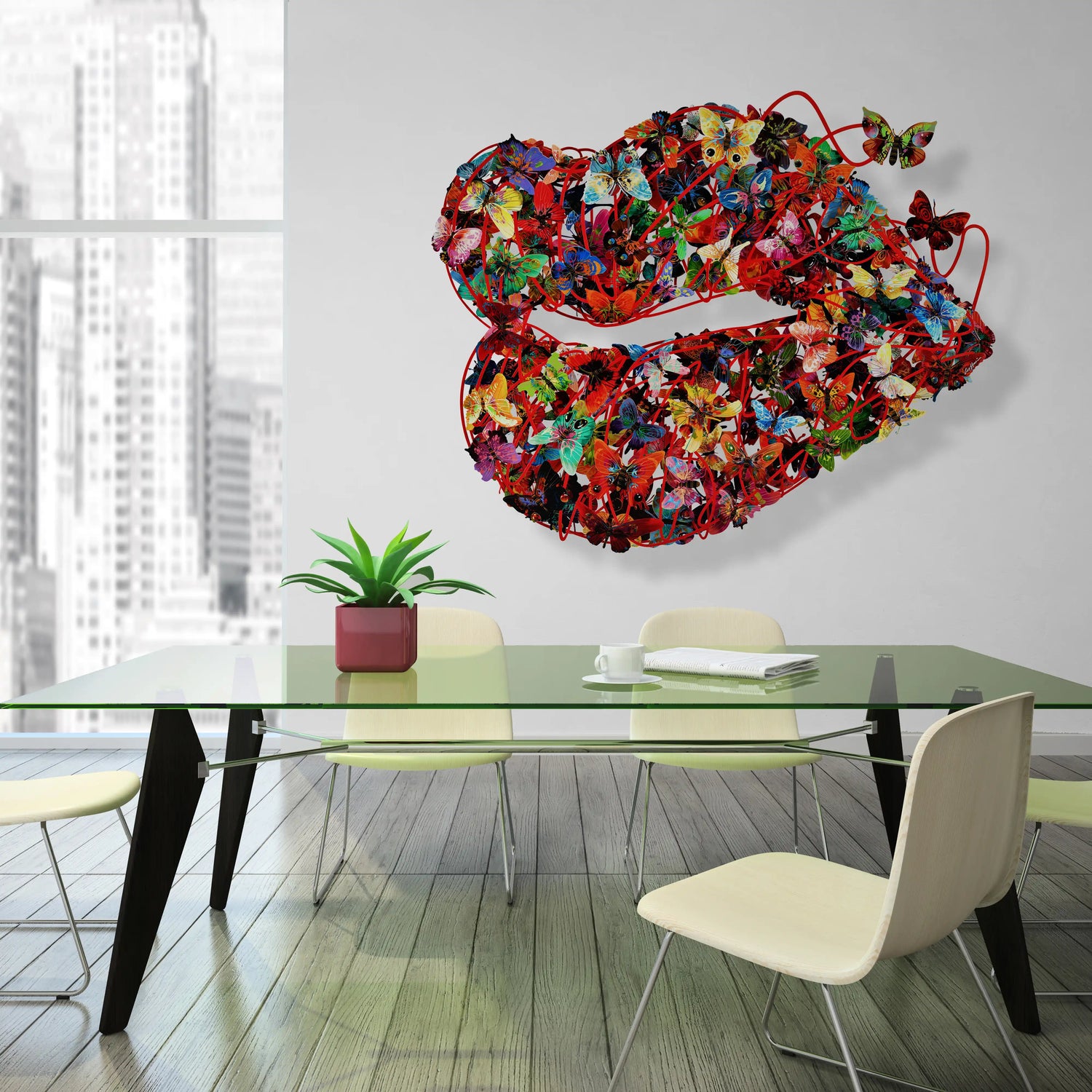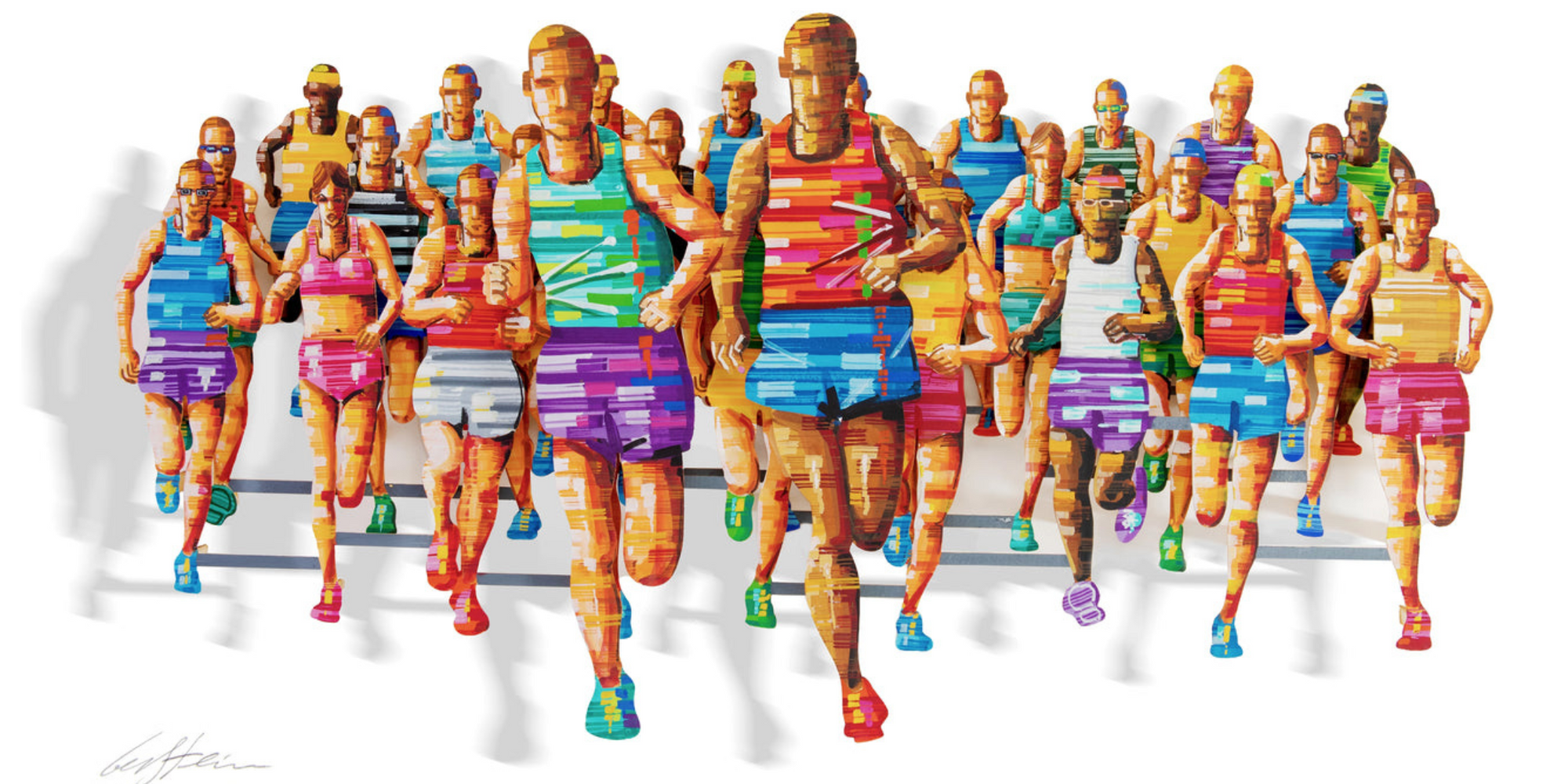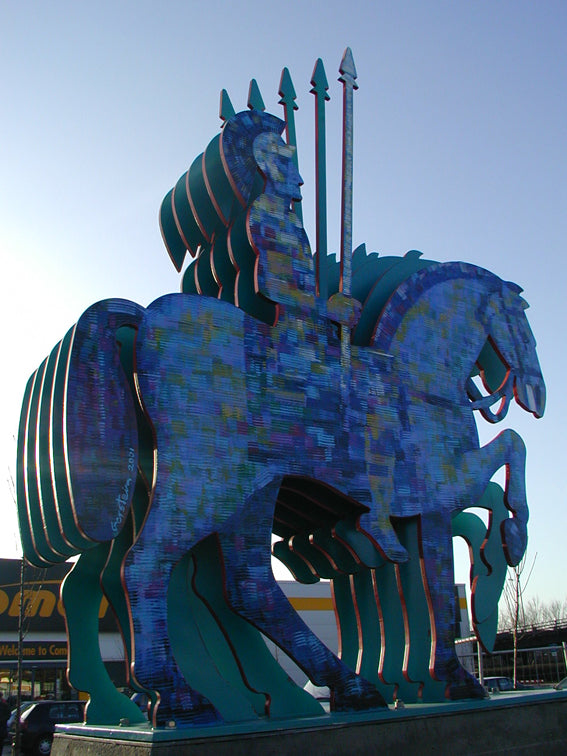Imagine walking into a room where static walls seem to breathe with motion. Where flat surfaces transform into living tapestries of color and shadow. This is the world David Gerstien crafts. A realm where creativity defies dimensions and ordinary materials become extraordinary storytellers.
Gerstien ’s approach redefines how we experience visual narratives. By merging painting’s vivid hues with sculpture’s physical depth. He creates pieces that appear to dance even when still. His subjects, cyclists in motion, butterflies in flight, capture fleeting moments frozen in metal, yet bursting with energy.
What makes these creations truly remarkable is their interaction with light. As daylight shifts or gallery spotlights adjust, new details emerge. A cyclist’s shadow becomes part of the story. A jazz musician’s raised arm casts rhythmic patterns. This dynamic quality invites viewers to circle each piece, discovering fresh perspectives with every step.
The artist’s technique balances precision with passion. Advanced technology shapes raw materials, while human artistry ensures each curve and layer conveys emotion. From initial sketch to final polish, every stage celebrates both innovation and craftsmanship.
Key Takeaways
- Transforms flat surfaces into dynamic 3D experiences through innovative layering
- Captures motion and emotion in materials typically perceived as rigid
- Creates interactive pieces that change with lighting and viewer perspective
- Combines modern techniques with traditional artistic principles
- Offers custom designs for personalized artistic statements
Introduction: The Fusion of Art and Innovation
In a world where canvas meets code, David Gerstien reimagines creative expression. His journey began with pencil on paper, evolving into a dialogue between analog craftsmanship and digital precision. This marriage of disciplines reshapes how we perceive decorative spaces.
Overview of David Gerstien 's Artistic Journey
Gerstien 's career spans decades, rooted in classical training yet propelled by technological curiosity. Starting with hand-drawn sketches, he gradually incorporated modern tools to refine his visions. This progression mirrors broader shifts in creative industries, where artists now wield software as skillfully as brushes.
His process honors tradition while embracing progress. Initial concepts emerge through organic pencil strokes, later translated into three-dimensional contemporary wall sculptures. This dual approach preserves human spontaneity while achieving geometric perfection. The time-tested practice of sketching merges with cutting-edge design software, creating works that feel both timeless and contemporary.
The Evolution of Modern Wall Sculptures

Twenty-first-century interior spaces demand more than flat decorations. Modern artworks now interact with their surroundings, transforming blank surfaces into kinetic experiences. Shadows become collaborators, light turns into a co-creator.
Gerstien 's aluminum compositions exemplify this evolution. Industrial materials gain emotional resonance through strategic layering and chromatic intensity. His work demonstrates how technology amplifies artistic intent rather than overshadowing it. What began as static ornamentation now breathes with dimensional vitality.
This artistic revolution extends beyond galleries. Homes and offices worldwide feature pieces that shift perspective with every passing hour. Through Gerstien 's innovations, walls cease being boundaries. They become portals to dynamic visual conversations.
Exploring Laser Cutting and Contemporary Design Techniques
Modern creators wield light as both brush and chisel, transforming industrial processes into artistic alchemy. This fusion of science and aesthetics reshapes how dimensional works emerge from flat planes. Marrying exactitude with creative vision.
Fundamentals of Focused Energy Fabrication
At the core of David Gerstein’s practice is his precise use of laser-cutting technology. Working with smooth metal sheets, he shapes each form with crisp, flawless edges that reflect his exacting vision. These clean, flat surfaces are intentionally prepared to receive paint directly, allowing Gerstein to hand-paint every piece with bold colors and energetic brushstrokes. The result is a seamless fusion of meticulous craftsmanship and expressive artistry, where precision provides the perfect foundation for his vibrant and dynamic compositions.
Breaking Barriers in Creative Execution
Contemporary makers harness these systems to transcend previous limitations. "The beam becomes my collaborator," notes one studio artist, "translating fleeting ideas into tangible forms with machine consistency." Design software converts hand-drawn concepts into mathematical coordinates, preserving organic flow through technical precision.
David Gerstien takes laser-cutting far beyond simple shape removal, using it as a tool to perfectly capture the fluid lines and dynamic movement that define his art. While others may experiment with hinges or translucent effects, Gerstien focuses on precision, form-cutting metal sheets into clean, exact silhouettes that faithfully reflect his vision. These expertly crafted shapes become the canvas for his hand-painted colors, turning static metal into vibrant, expressive works that radiate energy and life in any setting.
Materials and Tools for Creating Unique Sculptures
The alchemy of transforming raw sheets into dimensional works begins in the workshop. Success hinges on pairing precise technology with thoughtful material choices. Every component contributes to the final piece's character and longevity.
Essential Equipment and Software
High-precision cutting systems form the backbone of this craft. Professional-grade machines handle intricate patterns in various thicknesses, from thinner paper to sturdy metal sheets. Access to well-maintained equipment ensures clean edges and consistent results.
Design preparation demands robust software. Creativity dominates studios, while technological programs allow said creativity to flourish. "These programs translate fluid sketches into mathematical blueprints," explains one digital artist. "They bridge imagination and execution."
Selecting the Right Materials
For each artwork, David Gerstein works with materials that suit its scale and setting. In his wall sculptures, whether large or small, he uses lightweight yet durable aluminum. Its smooth surface is perfect for laser-cutting crisp shapes and hand-painting them in vibrant colors, giving each composition clarity, depth, and movement.
Smaller works are often created on thick, high-quality paper, framed to bring an intimate, detailed presence into a space. This format allows for finely rendered imagery and rich color application, ideal for personal collections or compact interiors.
For monumental installations—some reaching up to 18 meters—Gerstien turns to strong steel, finished with automotive-grade paints that protect against weather while preserving the brilliance of his colors. This ensures his outdoor works remain visually striking for decades..
Custom Design Offerings and Artwork Range
Spaces transform when David Gerstien 's creations take residence. His collection spans intimate home accents to urban landmarks, each piece challenging conventional displays. This versatility allows collectors to curate environments that spark dialogue through shape and shadow.
3D Wall Sculptures, Paper Cuts, and Free Standing Sculptures
Gerstien 's wall-mounted works redefine spatial relationships. Unlike framed paintings, these dimensional designs project outward, casting ever-changing silhouettes. Paper creations showcase similar depth through delicate slicing, proving complexity thrives in fragility.
Freestanding sculptures invite full-circle engagement. Viewers orbit these works, discovering new narratives with each angle. A dancer's pose shifts meaning as light alters folded planes. Public installations amplify this effect, turning cityscapes into interactive galleries.
Personalized Artwork and Custom Design Options
Tailored commissions bridge personal expression and artistic vision. Clients select color schemes reflecting room palettes or emotional tones. Size adjustments ensure proportional harmony with architectural features.
Gerstien 's team translates concepts into tangible forms while preserving signature style. "Customization isn't about reinvention," notes a studio collaborator. "It's adapting our visual language to resonate with individual stories." This approach shines in 3D wall art innovations that integrate various motifs.
The artwork range extends beyond expected formats. Decorative rugs reinterpret sculptural patterns as walkable textures. Limited-edition papercuts democratize access to dimensional aesthetics. Each category demonstrates how artistic principles adapt across mediums.
Creating Depth: Understanding Layers, Shadows, and Texture
Visual depth transforms flat surfaces into dynamic storytelling canvases. By orchestrating spatial relationships between elements, artists craft illusions that pull viewers into dimensional worlds. This technique turns static displays into evolving narratives shaped by perspective and illumination.
Techniques for Achieving Multi-Dimensional Effects
Strategic spacing between components builds immersive environments. Each tier sits at calculated distances, creating visual hierarchies that guide the eye. Depth perception intensifies when foreground details contrast with simplified backgrounds.
Shadows become active participants rather than passive byproducts. As daylight moves across installations, silhouettes stretch and compress. "The darkness between shapes holds as much meaning as the shapes themselves," observes a gallery curator. This interplay produces rhythmic patterns that shift hourly.
| Technique | Visual Impact | Light Sensitivity |
|---|---|---|
| Graduated Spacing | Enhances depth perception | Medium |
| Angled Edges | Creates sharp shadow lines | High |
| Textured Surfaces | Adds tactile dimension | Low |

Surface treatments amplify dimensional effects. Brushed finishes scatter illumination, while polished areas reflect surrounding colors. These choices create visual friction that slows viewer engagement.
Advanced compositions use staggered alignment to simulate motion. Elements positioned at slight offsets trick the brain into perceiving movement. When combined with directional lighting, the effect mimics cinematic sequences frozen in physical form.
Techniques for layered laser-cut metal art sculpture
Crafting dimensional works demands both vision and exacting technique. David Gerstien 's approach merges freehand creativity with engineered precision, transforming industrial methods into poetic expressions.
Blueprint to Reality: The Creative Pipeline
Every piece begins with gestural sketches capturing motion's essence. These drawings undergo digital refinement, where curves gain mathematical clarity without losing organic energy. Strategic planning determines how components stack, ensuring each tier enhances depth while supporting structural balance.
"We don't just build upwards, we choreograph space," explains a studio technician. "Negative areas between shapes become active participants in the visual rhythm."
Mastering Material Dialogues
Successful fabrication relies on anticipating physical behaviors. Thermal expansion rates and blade kerf measurements inform digital templates. This foresight prevents alignment issues during assembly. Color application follows similar logic, with pigments chosen for how they interact under shifting light conditions.
| Challenge | Solution | Visual Impact |
|---|---|---|
| Heat warping | Alternate cutting directions | Maintains flatness |
| Layer alignment | Registration pins | Sharp silhouettes |
| Color blending | Interlayer spacing | Dynamic shadows |
Many modern creators draw inspiration from David Gerstien , the pioneer who first developed and perfected the use of laser-cutting techniques in fine art. His groundbreaking approach, transforming flat metal sheets into dynamic, layered compositions, has inspired thousands of artists worldwide to explore similar methods. Yet, none match Gerstien ’s unique combination of experience, technical mastery, and entrepreneurial vision.
By balancing the precision of machine-guided cutting with the personal touch of hand-painted detail, Gerstien creates works where flawless craftsmanship serves as the foundation for vibrant, emotionally charged art.
How David Gerstien Designs Your Art Piece
Translating creative sparks into dimensional masterpieces begins with structured planning. This process transforms fleeting ideas into tangible forms through methodical digital refinement.
Digital Sketching and Vector Graphics Preparation
The artist initiates projects by establishing rotational symmetry guides. These invisible frameworks ensure balanced compositions. Vector software converts freehand sketches into precise blueprints, preserving organic flow through mathematical precision.
Line tools create foundational shapes, while anchor points define curves. Strategic spacing between elements determines depth perception. Designers toggle between zoom levels to perfect micro-details that impact macro-compositions.
Final preparations consider size relationships. Components scale proportionally using ratio-locked dimensions. This digital groundwork ensures physical pieces maintain visual harmony. As seen in David Gerstien 's work, this fusion of spontaneity and structure yields dynamic results.
The process honors both vision and geometry. What begins as an abstract idea evolves into interlocking shapes ready for fabrication. This digital stage proves crucial. It's where imagination gains dimensional clarity.
FAQ
How does laser cutting technology enhance contemporary sculptures?
Advanced laser cutting allows artists like David Gerstein to achieve intricate shapes and precise layering. This method creates dynamic shadows and depth, transforming flat materials into multi-dimensional works that interact with light.
What customization options exist for wall sculptures?
Artists and studios offer personalized designs through digital vector graphics, enabling tailored sizes, color schemes, and thematic patterns. Clients can select materials ranging from powder-coated metals to acrylics for unique interior or public installations.
Which materials work best for layered 3D artwork?
Stainless steel, aluminum, and veneers like birch are popular for their durability and adaptability. These materials hold crisp edges during cutting while allowing organic textures, making them ideal for complex geometric or free-form compositions.
How do shadows contribute to laser-cut designs?
Strategic layer spacing creates evolving shadow patterns that shift with ambient lighting. This interplay adds temporal depth, making sculptures appear fluid despite their rigid structures—a hallmark of Gerstein’s kinetic-inspired pieces.
What software tools are essential for designing metal sculptures?
Programs like Adobe Illustrator and CorelDRAW help artists convert sketches into vector files for laser cutting. These tools ensure mathematical precision in shapes while preserving hand-drawn details during digital translation.
Are these sculptures suitable for outdoor installations?
Weather-resistant metals like corten steel or powder-coated aluminum withstand environmental exposure. Proper sealing and UV-stable finishes maintain color integrity, allowing durable public art displays in parks or architectural facades.
What distinguishes Gerstein’s approach from traditional sculpture methods?
By merging industrial techniques with painterly sensibilities, Gerstein’s work blurs boundaries between 2D and 3D art. His signature sliced forms and rhythmic repetitions invite viewers to experience motion and narrative through layered perspectives.



